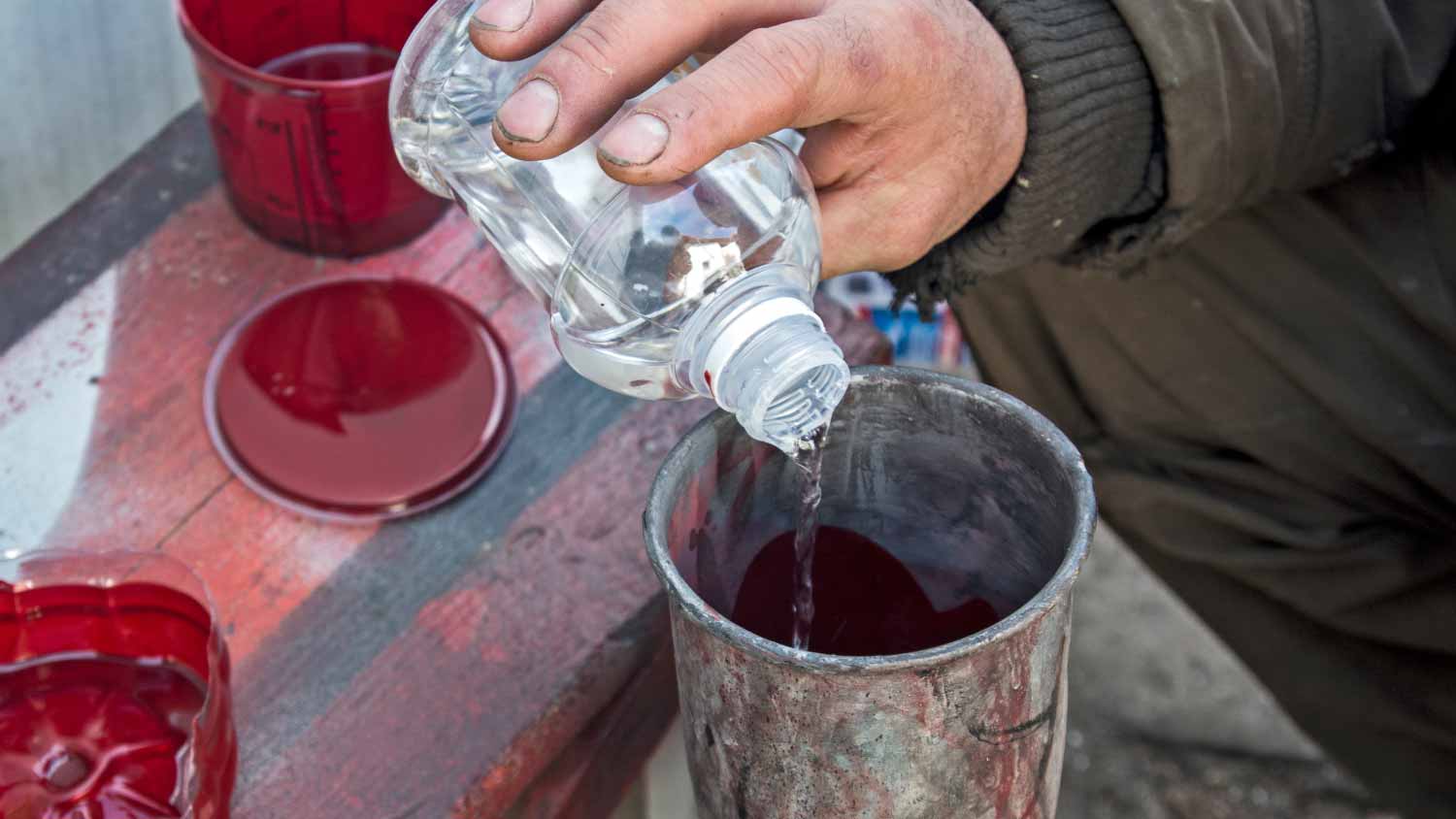
How much does it cost to paint a room? Learn what you’ll pay to give your space a makeover, depending on room size, paint type, the pro you hire, and more.
Just a splash is effective but makes a lot of fumes


Paint thinner is effective at diluting old-based paints and cleaning paint tools.
There are three common types of thinners, all containing volatile organic compounds.
There are eco-friendly alternatives for thinning or cleaning paint.
The cons of using traditional paint thinner often outweigh the pros.
What is paint thinner? It’s a staple in many paint projects, but its exact nature and purpose remain a mystery to many. Whether you're a do-it-yourself novice or DIY enthusiast, understanding what paint thinner is, how it works, and its various applications is essential for safe and effective use.
Paint thinner is a versatile solvent. Its primary function is to dilute oil-based paint to achieve the desired consistency for application. Simultaneously, it can clean brushes, rollers, other painting tools, and varnishes.
Most paint thinners contain volatile organic compounds (VOCs). While these chemicals make dissolving paint easier, they negatively impact the environment and human health. Contact a local interior painter to discuss your options for low-VOC paint.
Yes, there are three common types of paint thinner, each with its composition and intended use. The choice of paint thinner depends on the paint type, the painted surface, and personal preferences.
Mineral spirits are petroleum-derived solvents commonly used for thinning oil-based paints, stains, and varnishes. They are relatively mild compared to other solvents because they are lower in VOCs than other thinners and are suitable for general-purpose thinning and cleaning.
Turpentine is a natural solvent derived from pine trees suitable for oil painting. It has stronger solvent properties than mineral spirits and can be more effective in thinning and dissolving certain paints and varnishes. Turpentine has a strong odor and may cause skin irritation, so proper ventilation and protective gear are recommended.
When comparing paint thinner to acetone, the latter is a powerful solvent commonly used in nail polish remover and industrial applications. It effectively dissolves various materials, including oil-based paints and varnishes. Acetone evaporates quickly and leaves little residue, making it suitable for cleaning surfaces and tools.
Yes, there are several alternatives to traditional paint thinners, especially for those who prefer to avoid using petroleum-based solvents or are looking for more environmentally friendly options. However, some of these options can’t be used to thin oil paint, and they don’t pack the same punch when cleaning it up.
These are derived from citrus fruits like oranges or lemons and contain d-limonene, a natural solvent that can effectively thin oil-based paints, varnishes, and adhesives. Citrus-based solvents are biodegradable and emit a pleasant citrus scent, making them a safer and more environmentally friendly option.
Bio-based solvents are made from renewable sources such as corn, soybeans, or sugar, offering a more sustainable alternative to petroleum-based thinners. They are often biodegradable and less harmful to the environment. Lastly, these solvents best remove most flat and matte paint, and effectively remove graffiti from walls.
Also known as isopropyl alcohol, it can be used as a solvent to clean surfaces, such as removing dried paint stains. It evaporates quickly and leaves little residue, making it a convenient alternative to other solvents for small-scale projects. However, it should never be used to thin paint because it will cause it to separate.

While paint thinner offers effective thinning and cleaning capabilities for oil-based paints, stains, and varnishes, its use poses significant health and environmental risks.
| Pros of Paint Thinner | Cons of Paint Thinner |
|---|---|
| Effective | Contains VOCs |
| Versatile | Strong odor |
| Evaporates quickly | Flammable |
| Readily available | Not environmentally friendly |
Paint thinner is highly effective at thinning oil-based paints, stains, and varnishes to achieve the desired consistency for application. It helps improve the flow and spread of paint, resulting in smoother and more even coats.
Paint thinner is a versatile solvent that can also be used to degrease various surfaces. Its multiple applications make it a valuable tool for painters and DIY enthusiasts.
Paint thinner evaporates quickly, allowing for faster drying times between coats of paint. This helps expedite the painting process and allows more efficient time use during projects.
Paint thinner is readily available at most home improvement and hardware stores. Its accessibility makes it convenient for users to obtain when needed for painting projects.
Traditional paint thinners contain (VOCs) and other chemicals known to be harmful to human health if inhaled or absorbed through the skin. Prolonged exposure to paint thinner vapors may cause dizziness, nausea, headaches, and other health issues.
Paint thinner emits strong fumes with a pungent odor, which can be unpleasant and overwhelming, especially in poorly ventilated areas. The odor may linger for some time after use, affecting indoor air quality and causing discomfort for users.
Paint thinner is highly flammable, and if not handled and stored properly, it poses a fire hazard. It should be kept away from open flames, sparks, and heat sources to prevent accidents and ensure safety during use.
Traditional paint thinners are derived from petroleum and other fossil fuels, making them non-renewable resources with significant environmental impacts. Improper disposal of paint thinners can contribute to soil and water pollution, posing risks to ecosystems and wildlife.
From average costs to expert advice, get all the answers you need to get your job done.

How much does it cost to paint a room? Learn what you’ll pay to give your space a makeover, depending on room size, paint type, the pro you hire, and more.

The cost to paint the interior of a house in Austin, TX depends on size, layout, type of surface, and more. Learn what factors can influence your total in this guide.

The cost to paint the interior of a house in Denver, CO depends on size, layout, type of surface, and more. Learn what factors can influence your total in this guide.

Painting plastic requires the right paint to get the job done flawlessly. Check out 11 of the best paints for plastic to help you with your next project.

Need to refresh your home’s interior but not sure which paint to choose for your doors? Learn about the best paint for interior doors for look and longevity.

Need to remove old, chipping, or flaking paint before refreshing? Learn about paint removal costs in this guide to see how much you should budget.